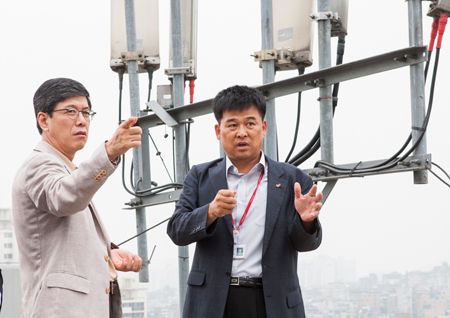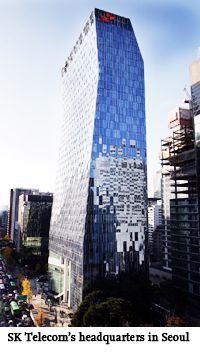
SK Telecom changes LTE landscape

Firm pledges technology upgrades for consumers
SK Telecom, Korea’s largest mobile carrier, has changed the landscape for the long-term evolution (LTE) services market by seeking ways to upgrade its technology.
Not satisfied with providing a nationwide LTE network, the firm has been keen to test the technological boundaries of what is possible in the next-generation service.
“As the leader in LTE, we must increase the quality of our networks quickly to meet the expectations of customers,” SK Telecom CEO Ha Sung-min told employees during an inspection of the company’s base transceiver station last month. “We must approach our customers with differentiated services.” The firm has over 5 million subscribers to the high speed wireless service as of August, half of the nation’s total user market.
SK Telecom became the 22nd firm to commercialize LTE when Korean telecommunication companies launched the service and started expanding networks last year.
However, it now has the third most LTE subscribers in the world, behind Verizon in the United States and Japan’s NTT Docomo, according to the Global Mobile Suppliers Associations report released this month. There are currently 96 companies globally that provide LTE.
“Just like there are differences between handsets when it comes to hardware capacity, not all LTEs are the same,” said SK Telecom spokesman Kim Dae-woong. “Now that we have full coverage that spans even the remotest parts of the country, we want to focus on how to make the service even better by applying advanced technologies that will make our network fast, stable and accessible anywhere.”
Network upgrade
SK Telecom has been eager to introduce new network technology to boost connection performances. It was the world’s first to install dual-mode femtocells (smaller sized stations than standard cellular base ones) in November last year which were commercialized in June. The broadband provider also boasts 1 million more repeaters installed in various locations than rivals.
The company was the first among domestic players to apply multi carrier (MC) technology to LTE. MC, like its name suggests, provides an additional broadband with an existing one that allows SK Telecom to prevent the network overloading. By using two frequency spectrums, one at 850 megabytes, the other at 1.8 gigabytes, data that is in danger of becoming log-jammed will automatically transfer to whichever one is less busy. Though the download speed is not doubled per se from its current maximum 75 megabytes, it will have a similar effect due to more broadband being available.
MC was launched in Seoul on July, the first anniversary since SK Telecom’s LTE commercialization, and will expand to 23 major cities by early next year. Within this month, a total of six handsets in the Korean market will support the LTE technology: Galaxy S3, Galaxy Note 2, Optimus Vu, Optimus G, Vega Race 2 and Vega R3. “We maintain close communication with mobile phone makers to ensure that their products are combatable with our networks and what they offer,” said Kim.
“MC allows incomparable service that subscribers to other carriers won’t be able to enjoy,” said a SK Telecom official. “We plan to buy a third band by 2013 to add another highway in order to further facilitate data traffic for the benefit of our users.”
Ultimately, the goal of SK Telecom is to realize carrier aggregation (CA) technology, which will combine spectrums to “truly” increase download speed by up to 150 megabytes. CA will be available to subscribers by the second half of next year.
New LTE-related services
“Though connection speed is important, consumers want more than that. Speed is just one aspect of increasing total experience. We want to show them what is possible with LTE,” said the spokesman.
SK Telecom is currently offering a premium voice call service through a technology called VOLTE (Voice over LTE) which started last month. What it does is transfer voice call signals that were transmitted through third-generation (3G) networks to the upgraded LTE one.
Dubbed “HD Voice” by the carrier, the call quality improves “drastically” because of improved voice codec and radio signal transmission. Connection to the other line takes .25 to 2.5 seconds, while 3G took 5 seconds on average. SK Telecom has held numerous demonstrations in places where it seems impossible to maintain connectivity due to territorial difficulties, such as in areas of open sea and mountain peaks over a kilometer above ground level. VOLTE works in all of them, says the mobile operator.
But HD Voices is just one among more LTE service to be unveiled. An as yet to be named service that applies rich communication suite (RCS) technology is planned for the second half of the year. RCS allows consumers to make voice calls, chat and send pictures or videos all simultaneously, and will be available in all popular handsets in the market by download apps.
“We were thrilled to be named the third largest company by number of LTE subscribers in the world. We will not lose this momentum. By collaborating with all of our other businesses, we will create new values for consumers that will make them not hesitate to choose SK Telecom when it comes to LTE,” said Kim. <The Korea Times/Cho Mu-hyun>


